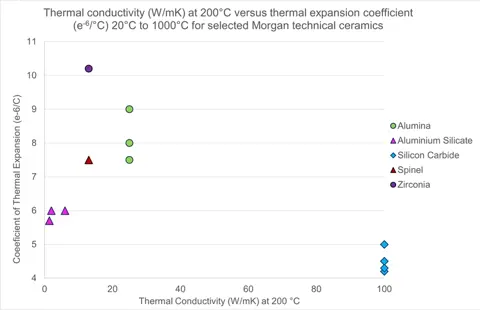Technical Ceramics

Coefficient of Thermal Expansion
Coefficient of Thermal Expansion (CTE), thermal coefficient of linear expansion, or thermal expansion coefficient
Contact usThe Coefficient of Thermal Expansion (α) indicates the fractional change of length of a material per a degree change in temperature while at a constant pressure. The value is specified as the change in unit length per degree of temperature.
Because a material’s thermal expansion behaviour generally changes with temperature, the temperature range over which the expansion measure was made is usually indicated, i.e. α (room temperature to 200°C).
| Ceramic | CTE (E-6) from 20-1000°C |
| Magnesia | 13.0 |
| ZTA | 10.2 |
| Zirconia | 9.0-10.0 |
| Alumina | 6.3-9.4 |
| Magnesium Aluminate | 7.0-8.0 |
| Aluminium Silicate | 5.7-6.3 |
| Silicon Carbide | 4.1-5.2 |
| Silicon Nitride | 3.0 |
| Fused Silica | 0.5 |
Thermal Expansion Coefficients
The thermal expansion coefficients of ceramics are generally lower than the coefficients of metallic alloys and unfilled polymers, although there is an overlap. When brazing to join a ceramic and metal alloy, this differential of expansion coefficient will cause strain within the braze interface between the two joined materials. Accordingly, careful selection of an appropriate braze alloy, for the joined materials and for the intended operating temperature range, is required.
Within advanced and specialty ceramics, magnesia and zirconia have some of the highest expansion coefficients, and fused silica has one of the lowest. Alumina being closely matched with titanium and nickel alloys make these materials particularly well suited for brazed assemblies.




